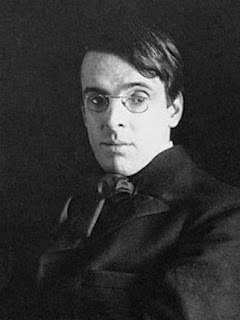Hello Friends! In this blog I am going to discuss 'The Second Coming' by W.B. Yeats. This task was given by our pro.Dr. Dilipbarad sir.
William Butler Yeats was an Irish poet, dramatist, writer and one of the foremost figures of 20th-century literature. He was a driving force behind the Irish Literary Revival and became a pillar of the Irish literary establishment who helped to found the Abbey Theatre, and in his later years served two terms as a Senator of the Irish Free State.
Original Poem
Turning and turning in the widening gyre
The falcon cannot hear the falconer;
Things fall apart; the centre cannot hold;
Mere anarchy is loosed upon the world,
The blood-dimmed tide is loosed, and everywhere
The ceremony of innocence is drowned;
The best lack all conviction, while the worst
Are full of passionate intensityI.
Surely some revelation is at hand;
Surely the Second Coming is at hand.
The Second Coming! Hardly are those words out
When a vast image out of Spiritus Mundi
Troubles my sight: somewhere in sands of the desert
A shape with lion body and the head of a man,
A gaze blank and pitiless as the sun,
Is moving its slow thighs, while all about it
Reel shadows of the indignant desert birds.
The darkness drops again; but now I know
That twenty centuries of stony sleep
Were vexed to nightmare by a rocking cradle,
And what rough beast, its hour come round at last,
Slouches towards Bethlehem to be born?
The Second Coming” is an allegorical poem that W. B. Yeats penned in 1919 and published in The Dial in 1920. The poem describes a declining, violent present and an impending apocalyptic future, marked by the approach of a sphinxlike monster. The poem is often considered an allegory for the fraught times Yeats was living in—namely, the end of World War I, the midst of the Spanish flu pandemic, and the beginning of the Irish War of Independence. More broadly, some scholars believe the poem bemoans the devolution of Europe and European culture.
“The Second Coming” is also indicative of Yeats’s interest in the occult. Yeats and his wife, Georgie Hyde-Lees, believed in a universal spirit world which they contacted for artistic inspiration. Yeats references this spirit world in “The Second Coming”.
The poem opens to the image of a falcon flying in a spiral, or “gyre,” that keeps widening, but the falcon can’t hear its master, the falconer. The rest of the lines in the first stanza examine the decaying state of the world: anarchy prevails, blood flows like a tide, and blood drowns all semblance of innocence. The surviving good people lack all conviction, and the “worst” people are excited and ambitious.
In the second stanza the speaker asserts that a revelation and Second Coming are occurring. Just as the speaker makes his prediction, he sees a disturbing image from Spiritus Mundi, the spiritual, universal consciousness: a sphinxlike shape with a lion’s body and a man’s head somewhere in a desert. The sphinx has a vacant, merciless expression and moves slowly, rousing desert birds. The speaker can no longer see the image, but he realises that after 20 centuries of calm, a rocking cradle has turned the world into a nightmare. The speaker ends the last two lines with a question: What is this monster? As he asks, the monster “slouches” to Bethlehem to be born.His wife caught the virus and was very close to death. The highest death rates of the 1918–19 pandemic were among pregnant women—in some areas, it was an up to 70 percent death rate for these women.So here we found this poem as pandemic.It was a very terrible situation as we are facing today because of CORONA pandemic.
In the end we can say that the poem 'The second coming' is a Pandemic poem.
On Being Asked for a War Poem
‘On Being Asked for a War Poem’ is a poem by W. B. Yeats (1865-1939), written in 1915 and published the following year. It’s one of Yeats’s shortest well-known poems, comprising just six lines, and sets out why Yeats chooses not to write a ‘war poem’ for publication.
Before we analyse ‘On Being Asked for a War Poem’, here’s a reminder of the text of the poem.
I think it better that in times like these
A poet’s mouth be silent, for in truth
We have no gift to set a statesman right;
He has had enough of meddling who can please
A young girl in the indolence of her youth,
Or an old man upon a winter’s night.
There is something of a contradiction to this poem: in a war poetry collection, it is a poem that refuses to speak about war. The poem says that it is not the place of a poet to write about politics, but that the poet instead should limit his interference in the world to pleasing his companions.
Structure :-
This poem is a sextet, with a rhyme scheme ABC, ABC. The first three lines refer to the poet’s attitude to writing about war; the next three lines write on the self-imposed limits of the poet’s interventions in the world.
Yeats maintains an ironic tone. He belittles the role of an Irish Poet to seduce a young woman and comfort and old man on his deathbed. He characterised poets as meddlers. Although he states a "poets mouth" should "be silent" he voices his opinion by writing the poem in the first place. He is against WW first.
In terms of its form, the poem is written in iambic pentameter, rhymed abc abc. The final two lines are the only ones which might cause some real head-scratching from readers (and critics), but Yeats appears to be making an appeal to the broad readership that poetry enjoyed: young girls might enjoy his romantic verses about old Ireland, while an old man might enjoy the ballads.



No comments:
Post a Comment